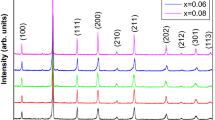Abstract
Phase structure, microstructure, piezoelectric and dielectric properties of the 0.4 wt% Ce doped 0.94Bi0.5Na0.5TiO3-0.06BaTiO3 (Ce-BNT6BT) ceramics sintered at different temperatures have been investigated. The powder X-ray diffraction patterns showed that all of the Ce-BNT6BT ceramics exhibited a single perovskite structure with the co-existence of the rhombohedral and tetragonal phase. The morphologies of inside and outside of the bulk indicated that the different sintering temperatures did not cause the second phase on the inside of bulk. However, the TiO2 existed on the outside of the bulk due to the Bi2O3 and Na2O volatilizing at higher temperature. The ceramics sintered at 1,200 °C showed a relatively large remnant polarization (P r) of about 34.2 μC/cm2, and a coercive field (E c) of about 22.6 kV/cm at room temperature. The permittivity ɛ r of the ceramics increased with the increasing of sintering temperature in antiferroelectric region, the depolarization temperature (T d) increased below 1,160 °C then decreased at higher sintering temperature. The resistivity (ρ) of the Ce-BNT6BT ceramics increased linearly as the sintering temperature increased below 1,180 °C, but reduced as the sintering temperature increased further. A maximum value of the ρ was 3.125 × 1010 ohm m for the Ce-BNT6BT ceramics sintered at 1,180 °C at room temperature.





Similar content being viewed by others
References
G.A. Smolenskii, V.A. Isupov, A.I. Agranovskaya, N.N. Krainik, Sov. Phys., Solid State 2(11), 2651–2654 (1961) (Engl. Transl.)
J. Suchanicz, K. Roleder, A. Kania, J. Handerek, Ferroelectrics 77, 107–110 (1988)
M.S. Hagiyev, I.H. Ismaizade, A.K. Abiyev, Ferroelectrics 56, 215–217 (1984)
T. Takenaka, K. Maruyama, K. Sakata, Jpn. J. Appl. Phys. 30 (9B), 2236–2239 (1991)
T. Takenaka, T. Okuda, K. Takegahara, Ferroelectrics 196, 175–178 (1997)
H. Nakada, N. Koizumi, T. Takenaka, Key Eng. Mater. 169, 37–40 (1999)
T. Takenaka, H. Nagata, Jpn. J. Appl. Phys. 36(9B), 6055–6057 (1997)
A. Herabut, A. Safari, J. Am. Ceram. Soc. 80(11), 2954–2958 (1997)
M. Onoe, H. Jumonji, J. Acoust. Soc. Am. 41(4), 74–80 (1967)
A.K. Singh, T.C. Goel, R.G. Mendiratta, O.P. Thakur, C. Prakash, J. Appl. Phys. 91, 6626 (2002)
Acknowledgements
This work has been supported by the National Nature Science Foundation (No. 50672075) and the Xi’an S&T Research Foundation (No. GG05015, No. GG06023), the EYTP and NCET and SRPDF (No. 20050699011) Program of MOE, Science Creative Foundation NPU of China.
Author information
Authors and Affiliations
Corresponding author
Rights and permissions
About this article
Cite this article
Fan, H., Liu, L. Microstructure and electrical properties of the rare-earth doped 0.94Na0.5Bi0.5TiO3-0.06BaTiO3 piezoelectric ceramics. J Electroceram 21, 300–304 (2008). https://doi.org/10.1007/s10832-007-9147-x
Published:
Issue Date:
DOI: https://doi.org/10.1007/s10832-007-9147-x



